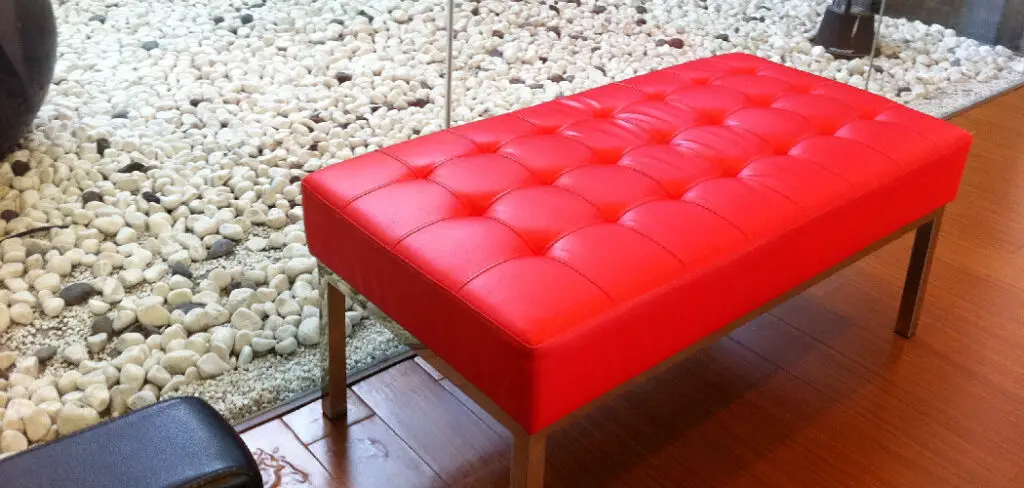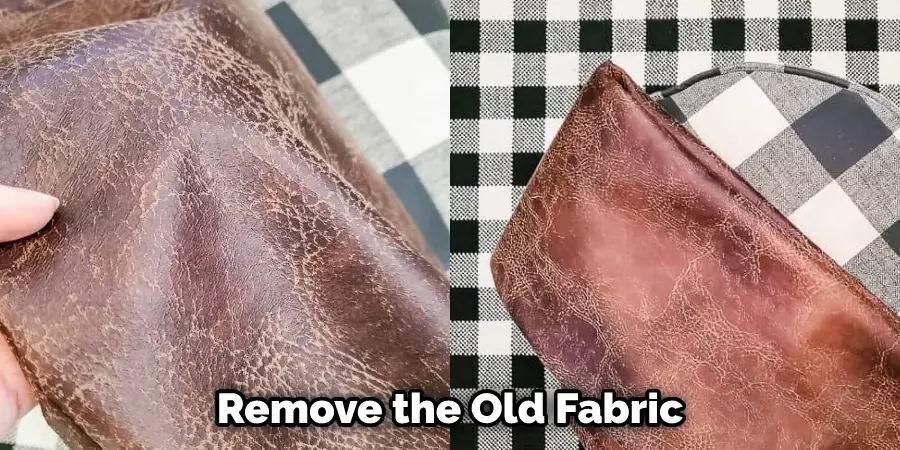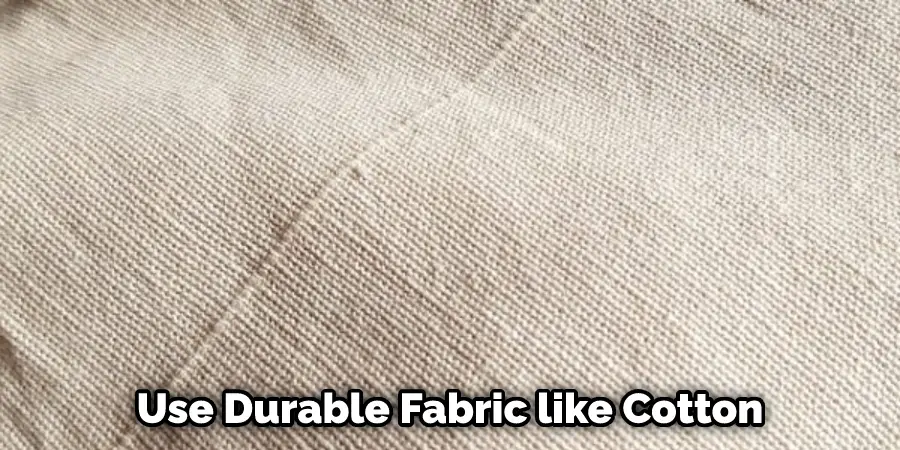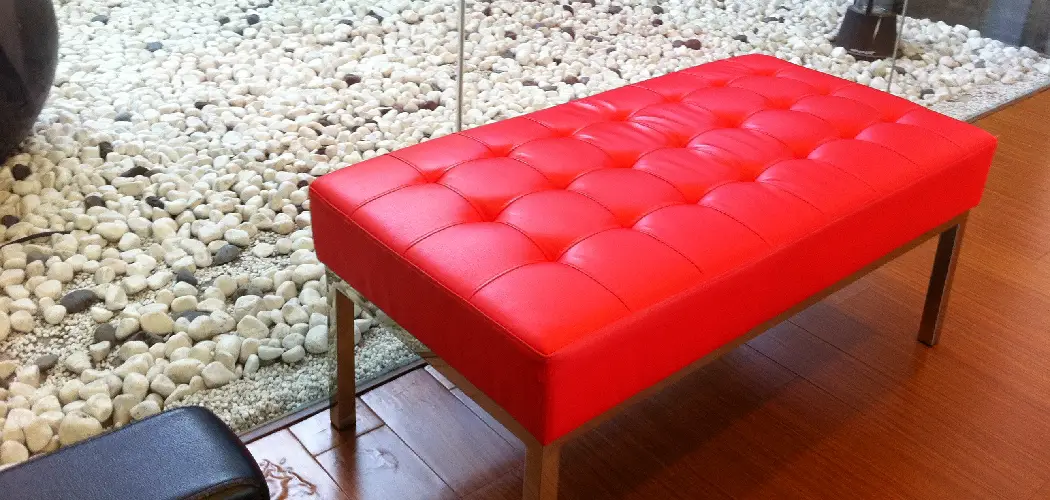A leather ottoman can add a touch of elegance to any room. But over time, the leather can start to show its age. So if your ottoman is starting to look a bit worn, you don’t have to throw it out. Instead, you can give it new life by reupholstering it with a little time and effort. Here’s how to reupholster a leather ottoman.

What Is a Leather Ottoman?
A leather ottoman is a piece of furniture that can be used as both a seat and a footrest. It is typically upholstered in leather and can be found in various styles and designs. Leather ottomans are often used as accent pieces in living rooms and bedrooms and can add a touch of luxury to any space.
In addition to their aesthetic appeal, leather ottomans are also known for their comfort and durability. When shopping for a leather ottoman, it is important to consider the size, shape, and style that will best suit your needs. Whether you are looking for a sophisticated statement piece or a cozy place to rest your feet, a leather ottoman is sure to add both function and style to your home.
Why Should You Reupholster a Leather Ottoman?
There are many reasons to reupholster a leather ottoman. First, it can help to extend the life of the ottoman. Over time, leather can become worn and cracked, making it less comfortable to use. You can give it a new lease on life by reupholstering the ottoman. Second, reupholstering can help to change the look of the ottoman. New fabric can make a big difference if you’re tired of how it looks.
Third, re-upholstering can be a great way to save money. Buying a new ottoman can be expensive, but reupholstering an existing one is much more affordable. Finally, re-upholstering can be a fun and rewarding DIY project. If you’re up for a challenge, it’s a great way to show off your creative side. Whether you’re looking to extend the life of your ottoman or simply change its look, reupholstering is a great option.
7 Steps to Follow on How to Reupholster a Leather Ottoman
1. Remove the Old Fabric
Start by taking off the old fabric. Then, use a screwdriver to remove the staples that are holding it in place. Be careful not to damage the leather underneath as you work.

2. Measure the New Fabric
Once the old fabric is removed, measure the new fabric you’ll use to reupholster the ottoman. Add an extra inch or two to your measurements to account for any wrinkles or imperfections in the fabric.
3. Cut the New Fabric
Cut the new fabric to size using a sharp pair of scissors. Make sure that all of the cuts are straight so that your final product looks professional.
4. Attach the New Fabric
Use a staple gun to attach the new piece of fabric to the underside of the ottoman. Start in the middle and work your way outwards, ensuring that the fabric is stretched tight as you go along.
5. Trim Any Excess Fabric
Once the new fabric is in place, use a sharp knife or a pair of scissors to trim away any excess material hanging over the edge of the ottoman.
6. Reattach the Legs
If your ottoman has removable legs, reattach them now. Make sure that they are screwed in tightly so that the ottoman is stable and won’t tip over.
7. Enjoy Your New Ottoman!
Sit back and enjoy your newly upholstered ottoman. This project is relatively easy to do and can give an old piece of furniture a whole new lease on life.
That’s it! You’ve now learned how to reupholster a leather ottoman. This project is relatively easy to do and can save you much money compared to buying a new piece of furniture. With a little time and effort, you can have a beautiful ottoman that looks like it was just bought from a store.
How to Choose the Right Fabric for Your Ottoman
When it comes to choosing a fabric for an ottoman, there are a few things to keep in mind. First, consider the intended use of the ottoman. For example, a delicate fabric like silk or velvet would be a good choice if it will be used primarily for decoration.

However, if the ottoman will be used for regular seating, then a more durable fabric like cotton or wool would be a better option. Another factor to consider is the climate. If the ottoman will be used in a room that gets a lot of sunlight, then a light-colored fabric would be a good choice to prevent fading.
Conversely, if the ottoman will be used in a room with low lighting, then a dark-colored fabric would be a better option. Finally, consider your personal style. Do you prefer bold patterns or subdued colors? Once you’ve considered all of these factors, you’ll be sure to choose the right fabric for your ottoman.
How to Add Decorative Trimming Around the Edge of Your Ottoman
Ottomans are versatile pieces of furniture that can be used as a footrest, extra seating, or even a coffee table. But sometimes, an ottoman can look a bit too plain. If you want to add a little extra flair to your ottoman, try adding some decorative trimming around the edge. This can be a simple way to give your ottoman a new look without spending much money.
There are several types of decorative trimmings that you can use, such as fringe, tassels, or ribbon. Simply choose the type of trimming that you like and then attach it to the ottoman with glue or stitches. You can also use trimming to create patterns or shapes on the ottoman. For example, you could create a border around the edge of the ottoman or make a geometric design in the center. Be creative and have fun with it!
Frequently Asked Questions
Can You Reupholster Over Existing Leather?
Yes, you can reupholster over existing leather. This is a common technique for updating or repairing old furniture. You will need to be sure to use the correct materials and techniques for proper reupholstery. Be sure to get professional help if you are not familiar with this process.
What is the Best Fabric to Reupholster an Ottoman?
The best fabric for reupholster an ottoman will depend on a variety of factors, including the type of ottoman and the color and style of the fabric. Some possible fabrics that could be used for reupholster an ottoman include:
Cotton twill: This fabric is water resistant and easy to care for, making it a good choice for ottomans that are used in high-traffic areas or that are subject to regular wear and tear.
Satin: Satin is a smooth, lightweight fabric that is both durable and stylish. It is a good choice for ottomans that are intended to be displayed rather than used.
Linen: Linen is a luxurious fabric with a high quality texture and a natural sheen. It is a good choice for ottomans that will be used primarily for seated or reclining activities.
Cashmere: Cashmere is a soft, luxurious fabric with a subtle sheen. It is a good choice for ottomans that will be used mainly for sleeping or sitting in comfort.
It is important to choose the right fabric for your ottoman based on its intended use and desired appearance. By consulting with an expert, you can ensure that the reupholster job goes smoothly and meets your expectations.
How Do You Restore Badly Worn Leather?
There are a few basic steps you can take to restore badly worn leather:
1. Clean the surface with a mild soap and water solution.
2. Apply a coat of leather restoration cream to the surface.
3. Let the cream dry completely before buffing it off with a cloth or a horsehair brush.
4. repeat steps 2-4 as necessary until the leather appears smooth and shiny.
Is It Cheaper to Reupholster?
The cost of reupholstering will vary depending on the size and complexity of the project, the materials used, and the skills of the reupholsterator. In general, though, it is usually cheaper to reupholster a chair or sofa than to purchase a new one.
Conclusion
With a little time and effort, you can easily reupholster a leather ottoman yourself! Just follow these simple instructions, and your ottoman will look new again in no time! Thanks for reading our post about how to reupholster a leather ottoman.

